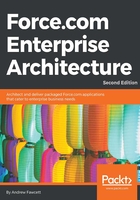
Required organizations
Several Salesforce organizations are required to develop, package, and test your application. You can sign up for these organizations at https://developer.salesforce.com/. Though in due course, as your relationship with Salesforce becomes more formal, you will have the option of accessing their Partner Portal website to create organizations of different types and capabilities. We will discuss this in more detail later.
It's a good idea to have some kind of naming convention to keep track of the different organizations and logins. Use the following table as a guide and create the following organizations via https://developer.salesforce.com/. As stated earlier, these organizations will be used only for the purposes of learning and exploring throughout this book:

Note
You will have to substitute myapp and my.com (perhaps by reusing your company domain name to avoid naming conflicts) with your own values. You should take the time to familiarize yourself with andyapp@packaging.andyinthecloud.com.
The following are other organization types that you will eventually need in order to manage the publication and licensing of your application. However, they are not needed to complete the chapters in this book:

Typically, the LMO and APO can be the same as your primary Salesforce production org, which allows you to track all your leads and future opportunities in the same place. This leads to the rule of APO = LMO = production org. Though neither of them should be your actual developer or test orgs, you can work with Salesforce support and your Salesforce account manager to plan and assign these orgs.